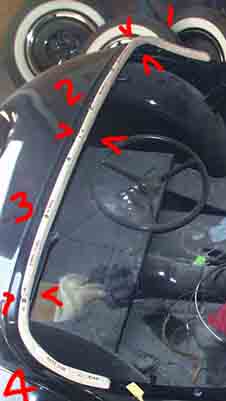
Bantam Roadster Cockpit wood
(From Oct 1999 Roostertails)
On my 1938 Bantam roadster, the wood pieces that the top studs
go into are above the body shell. At the rear of the cockpit,
the body sheet metal turns up about 5/16". The front edge
of the wood pieces bear against this edge. The wood is covered
with upholstery material. There
are four wood pieces. Starting at centerline, there are two
pieces about 22" long, one at each side of center. The end
pieces are each about 10" long, developed length. All four
pieces have compound curves, and are very difficult to reproduce.
The cross section of the wood is about 3/4"
wide and about 1" high. The wood is fastened to the top of
the body shell edge with ten 1/4" carriage bolts with washers
, lock washers and square nuts below. My 38 roadster doesn't have
a 1" by 1/8" rear belt rail to wheelhouse brace at
each side to provide reinforcing in case someone sat up on the
rear body shell. I have seen these braces on some of the later
roadsters. (The pictures 39 roadster does have there braces, but
if you sit on my car I will kill you-ed)
---------
You might want to try the procedure for making the wood yourself
as described by Ken Tebay in issue 149, Feb. 2000 of Rooster Tails.
This is a laminating process using 1/8 inch thick wood door skin
material. When completed and covered with upholstery material,
only you will know it is not the original type made with 4 separate
pieces.
______
Here's what I did...see picture for results.
By making extremely thin lathe, as broad as possible with a 7"
table saw using a smooth/planing blade and a lot of clamps (Harbor
Freight) and a good wood glue (ordinarily would use West System
marine epoxy but couldn't find any locally) I am able to lay up
four separate pieces of the proper shape using the back of an
old roadster as a buck.
One problem with this latter is that there are slight differences in the bodies, however if you have the basic measurements correct (especially width) you can add strips or subtract by grinding/sanding later to get a proper fit. Looks aren't too important because this is covered with upholstery material: moreover the carriage bolts will bring the metal to the wood some. Also using the old body as a buck there is a possibility that the old tin will flex a bit. I suppose one of us should make a regular buck our of steel strap set up on a base and legs so claming is easy and can be done from both sides. This way the whole piece could be made at once much easier.
The easiest way to do this is to make a several day project
out of it by adding only a quarter of an inch or so of lathe at
a time: otherwise it slides around and is a big mess. This way
you can also overlap pieces as you would with corners in a stone
wall to make it stonger.
